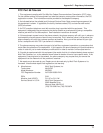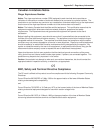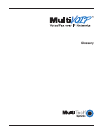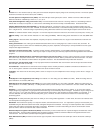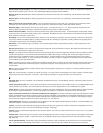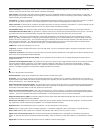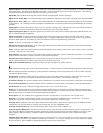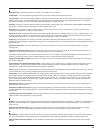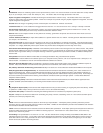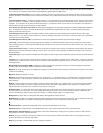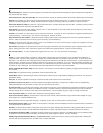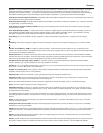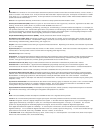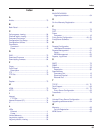
89
Glossary
S
Serial Port: The connector on a PC used to attach serial devices (those that need to receive data one bit after another), such as a mouse, a
printer or a modem. This consists of a 9- or 25-pin connector that sends data in sequence (bit by bit). Serial ports are referred to as "COMx"
ports, where x is 1 to 4 (COM1 through COM4). A serial port contains a conversion chip called a "UART" which translates between internal
parallel and external serial formats.
Service: The requirements offered by an RPOA to its customers to satisfy specific telecommunications needs.
Severely Errored Seconds (SES): Refers to a typical T1 error event where an error burst occurs (a short term, high bit-error rate that is self-
clearing). Per the ITU-T (CCITT) G.821: any second in which the BER is less than 1x10
-3
.
Signaling: The process of establishing, maintaining, accounting for, and terminating a connection between two endpoints. For example, the
user premises and the telco CO. Central office signals to the user premises can include ringing, dial tone, speech signals, and so on. Signals
from the user's telephone can include off-hook, dialing, speech to far-end party, and on-hook signals. In-band signaling techniques include
pulse and tone dialing. With common channel signaling, information is carried out-of-band.
Simple Network Management Protocol (SNMP): TCP/IP protocol that allows network management.
Simultaneous Voice Data (SVD): A technology for letting a user send data via a modem, and use a handset to talk to another user at the
same time over the same connection. The alternative, making a second call, can be expensive or even impossible. The uses for SVD are
telecommuting, videoconferencing, distant learning, tech support, etc.
Stop Bit: One of the variables used for timing in asynchronous data transmission. Depending on the devices, each character may be trailed
by 1, 1.5, or 2 stop bits.
Superframe (D4): A T1 transmission format that consists of 12 DS1 frames, or 2316 bits. A DS1 frame consists of 193 bit positions. A frame
overhead bit is in the first position, and it is used for frame and signaling phase alignment only.
Subscriber Loop: See "Local loop".
Switched 56: A circuit-switched (full duplex digital synchronous data transmission) service that lets you dial a number and transmit data to it
at 56K bps. It is a relatively low cost service, widely used in North America for telecommuting, videoconferencing and high speed data
transfers. Many phone companies are (or will be) phasing out Switched 56 in favor of ISDN service.
Switched Virtual Circuit (SVC): A type of data transmission where the connection is maintained only until the call is cleared.
Switched Line: In communications, a physical channel established by dynamically connecting one or more discreet segments. This
connection lasts for the duration of the call after which each segment may be used as part of a different channel. Contrast with leased line.
Switched Network: A network in which a temporary connection is established from one point via one or more segments.
Synchronous Data Link Control (SDLC): A discipline conforming to subsets of the Advanced Data Communications Control Procedures
(ADCCP) of the American National Standards Institute (ANSI) and High-level Data Link Control (HDLC) of the International Organization for
Standardization, for managing synchronous, code-transparent, serial-by-bit information transfer over a link connection. Transmission
exchanges may be duplex, or half-duplex over switched or nonswitched links. The configuration of the link connection may be point-to-point,
multipoint, or loop.
Synchronous Transmission: The transmission of data which involves sending a group of characters in a packet. This is a common method
of transmission between computers on a network or between modems. One or more synchronous characters are transmitted to confirm
clocking before each packet of data is transmitted. Compare to Asynchronous Transmission.
Systems Network Architecture (SNA): The description of the logical structure, formats, protocols, and operational sequences for transmit-
ting information units through, and controlling the configuration and operation of of, networks.
T
Tariff: The rate/availability schedule for telephone and ISDN services from a regulated service provider.
TCP/IP: A set of communication protocols that support peer-to-peer connectivity functions for both local and wide area networks.
T Carrier: The generic name for a digitally multiplexed carrier system. In the North American digital hierarchy, a T is used to designate a DS
(digital signal) level hierarchy. Examples: T1 (DS1) is a 1.544 M bps 24-channel designation. In Europe, T1 is called E1. The T Carrier
system was originally designed for transmitting digitized voice signals, but has since been adapted for digital data applications.
T1: A digital transmission link capable of 1.544M bps. T1 uses two pairs of normal UTP, and can handle 24 voice conversations, each
digitized at 64K bps. T1 is a standard for digital transmission in the U.S., Canada, Japan and Hong Kong. T1 is the access method for high-
speed services such as ATM, frame relay, and SMDS. See also T Carrier, T1 line and FT1.
T1 Channel Tests: A set of diagnostics that vary by carrier, used to verify a T1 channel operation. Can include Tone, Noise Level, Impulse
Noise Level, Echo Cancellors, Gain, and Crosstalk testing.



